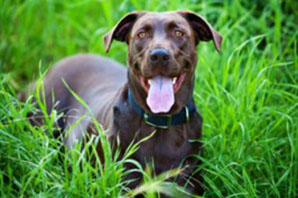Big dog breeds: what to consider when buying Great Danes, Irish Wolfhounds and more

Living with a large, boisterous dog can be an incredibly rewarding experience.
However, whilst a big dog can be perfect for many people, potential owners should be aware of many different considerations including the extra space needed, the cost of feeding such large pets, whether they are suitable around your children, and the extra exercise required.
Amongst the most important considerations though are the health problems and reduced life expectancy of many large breeds.
Petplan takes a look at five of the most popular big dog breeds and what you need to consider if you’re considering purchasing one…
Newfoundland
Newfoundland characteristics
Newfoundlands are large, strong dogs who can make a great family pet. With the potential to reach 2 feet, 5 inches at shoulder height, the Newfoundland was originally used as a working dog to pull fisherman’s nets or wood for lumberjacks and are brilliant swimmers.
Newfoundland health issues
You should take it very easy with exercise during the first two years of a Newfoundland’s life as their growth plates (soft areas that sit at the end of bones in puppies and young dogs and contain rapidly dividing cells that allow bones to become longer until the end of puberty) are still forming and hard exercise can cause damage to these plates.
The rupturing of the Arteria Cruciate Ligament can sometimes occur in the breed. Depending on the degree of severity, such injuries can result in surgery, making having the right dog insurance vital.
More dangerously, Newfoundlanders can sometimes suffer from Gastric Torsion. This is a life-threatening condition whereby the stomach stretches due to an increase in gas and can result in the stomach twisting. It is predominantly found in large, deep-chested dogs.
Early signs of the condition include restlessness, increased breathing rate or effort, excessive drooling, vomiting white froth or trying, unsuccessfully to vomit. As the condition progresses you may notice the abdomen becomes enlarged, the gums become pale and your dog may collapse. If you suspect your dog has a Gastric Torsion you should seek immediate veterinary treatment as success rates decrease the longer the delay in starting treatment.
Great Dane
Great Dane characteristics
The Great Dane is a beautiful and regal dog who holds an aura of nobility as a result of his tall stature of up to 2 feet, 10 inches. They are something of a gentle giant and love spending time around people.
Great Dane health issues
Whilst their size was an asset for their original purpose as hunting dogs, it can be a detriment to their health.
As well as suffering from Gastric Torsion like the Newfoundland, the Great Dane is also at higher risk of bone cancer than small dogs. Symptoms include lameness which, if you notice in your Great Dane, means you should take them to the vet immediately.
It should also be noted that the size of this dog actually makes surgery more difficult, and requires specialist care. Make sure you are clued up on the breed and ask your vet all the relevant questions when taking them for a check-up.
Bernese mountain dog
Bernese characteristics
The Bernese mountain dog is a Swiss dog whose size of up to 2 feet, 3 inches, makes this breed perfect for their traditional roles of helping herd cattle and pulling carts. With long hair and a sweet-natured disposition they are a warm and welcoming pet.
Bernese health issues
Bernese are a comparatively healthy large breed of dog, but owners should note the possible conditions that can result from its size.
Such conditions include Elbow Dysplasia, which is a degenerative disease sometimes found in large-breed dogs. This is where the dog suffers from a weakened or malformed joint as a result of abnormal growth. The treatment varies due to severity from simple medication to complex surgery.
Irish wolfhound
Irish wolfhound characteristics
The size of this enormous dog (2 feet, 11 inches) made it perfect for its traditional roles of hunting and pulling men off their horses in wars. Today, this shaggy-haired dog can make an ideal pet for many thanks to their ability to form deep bonds with their owners and their desire to be included in all aspects of family life.
Irish wolfhound health issues
Due to the Irish wolfhound’s size, it too, can be prone to suffering from bone cancer, elbow dysplasia and hip dysplasia.
Other conditions that can affect wolfhounds include heart disease caused by the heart muscle becoming thin and being unable to contract properly. Symptoms include abnormal heart rhythm, loss of appetite, weakness, weight-loss and depression.
Leonberger
Leonberger characteristics
A cross between a Newfoundland, a Saint Bernard and Great Pyrenees it’s no surprise that the Leonberger can grow up to 2 feet, 7 inches tall. They, like many other big breeds of dog, love being around people and need roughly an hour of exercise a day.
Leonberger health issues
As well as hip dysplasia, the Leonberger’s size increases the risk of being afflicted by Panosteitis (bone inflammation). This is when the large bones in the legs of young dogs become inflamed, making it painful for the dog to walk or move around. There is no one cure for this condition – it has to be allowed to run its course – but pain management is incredibly important and you should consult your vet if they have any symptoms including a hesitance to walk and outward exhibitions of pain.
With Leonbergers - as with all dogs - it's vital to have the right dog insurance to ensure your pet is covered and you can enjoy your time owning a large dog
Do you have any experience owning a large dog breed? Let us know your stories below…

